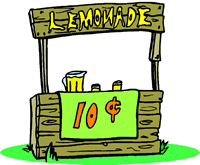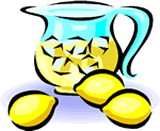Lemon Squeeze – The Lemonade Stand


Everyone has at one time or another opened a lemonade or Kool-Aid Stand. What a great place to begin an economics lesson. Students can taste test three brands of lemonade and compare prices with taste – is the most expensive the best? Using a reader’s theater students will construct a supply and demand schedule and can create a bar or line graph to demonstrate market interaction between buyers and sellers.
Introduction
 Have you ever thought about setting up your own lemonade stand on a hot day? Did you hope it would make enough money so that you could have some pocket change or buy something special? Did you do any research on what lemonade brand people liked? Or what would be a good price to charge?
Have you ever thought about setting up your own lemonade stand on a hot day? Did you hope it would make enough money so that you could have some pocket change or buy something special? Did you do any research on what lemonade brand people liked? Or what would be a good price to charge?
Do you know where lemons came from? Where in the world they are grown? How many lemons can grow on a single tree? A great "from scratch" lemonade recipe?
In this lesson you will:
- Learn what a taste test is.
- Learn how to take a sample of demand for lemonade.
- Review Max’s supply schedule for lemonade.
- Create a supply and demand schedule either by yourself or with your class.
- Discover where lemons are grown.
- Discover a great recipe for making refreshing lemonade from scratch.
Learning Objectives
- Interpret a demand schedule and observe that consumers will buy more at lower prices and less at higher prices.
- Interpret a supply schedule and observe that producers supply more at higher prices and less at lower prices.
- Interpret a supply and demand schedule to determine the market clearing price.
- Predict what will happen to demand when factors other than price change.
- Predict what will happen to supply when there is a change in the cost of production.
Resource List
-
Lemonade Taste Tally: Use this chart to tally up students responses for each type of lemonade.
Tally Chart
-
The Lemon Story: This story gives students some background knowledge on lemons.
The Lemon Story
-
Readers Theater – Max's Dilemma: A play for students to act out in class.
Play
-
Lemonade Recipe: Use this recipe to provide a special treat when the students are finished.
www.econedlink.org/lessons/docs_lessons/369_recipe2.pdf
-
Lemon Puzzler: Crossword puzzle to be filled out in the evaluation.
www.econedlink.org/lessons/docs_lessons/369_LemonPuzzler2.pdf
-
Sunkist Kids: Explore these pages for exciting games and experiments.
https://www.sunkist.com/
Process
History
Have the students read "The Lemon Story." "The Lemon Story" describes where lemons come from. The information in this story may help student with the Lemon Puzzler later on in this lesson.
 Taste Testing
Taste Testing
-
Prepare three jugs of lemonade: One made from frozen concentrate, one made from powder, and one already prepared/ready to drink.
-
Label each jug A, B, or C. Present the three jugs to your students, but don't tell them which type of lemonade is in each jug. Give each student three small paper cups, also labeled A, B, C. Give each student a small sample of each variety of lemonade for tasting–the A lemonade in the A cups, B in the B cups, etc. After the students have tasted all three varieties, as them to rank each variety, individually, as Best, Good, or OK.
-
Tally up student responses for each type of lemonade on this tally chart.
-
Which type of lemonade was designated as Best? Discuss the differences: what made one better than the other?
-
In the students' rankings, is there a relationship between preferred taste and price?
- Which of the three varieties do you think would sell the best in your lemonade stand?
Max’s Dilemma
-
The day before the lesson, provide one copy per student of the play, and assign roles.
-
Tell the students not selected to be a character in the play that they will be members of the audience and will help Max solve his problem.
-
In the play, Max asks his friends how many cups of lemonade they would buy each day at various prices; record the amounts on a demand schedule on the board.
-
As Max discusses how many cups of lemonade he would be willing and able to supply at various prices, complete the supply schedule on the board.
- Review the activity as follows:
- Study the demand schedule. What does this list of prices and amounts tell us about consumer behavior in the marketplace? [At higher prices, consumers are willing and able to buy less than at lower prices.]
- Study the supply schedule. What does this list of prices and amounts tell us about producer behavior in the marketplace? [At higher prices, producers are willing and able to supply more than at lower prices.]
- Why is Max willing to supply more lemonade at higher prices and less at lower prices? [Max will supply more at higher prices because his profit is greater and therefore, the opportunity cost of other ventures is lower.]
- At what price should Max sell his lemonade? [30 cents – at 30 cents the amount the group is willing and able to buy equals the amount Max is willing and able to supply. Tell the class this is called the market clearing price.]
- Why is Max unwilling to sell his lemonade for 20 cents? [At that price he only makes 2 cents profit per cup. It’s just not worth Max’s time.]
- What will happen if Max tries to sell his lemonade at 40 cents per cup? [At 40 cents, Max will have a surplus of 5 cups of lemonade.]
-
How will each of the following situations affect the demand for Max’s lemonade?

- The weather is cold and rainy. [Demand decreases.]
- The local senior citizens’ center surprises the group and pays them for the yard work they volunteered to do for the center.[Demand increases.]
- Max gives a free bag of popcorn with every glass of lemonade. [Demand increases.]
- The YMCA sells fruit punch for 25 cents per cup. [Demand decreases.]
-
How will each of the following affect the supply of lemonade at Max’s stand?
- The supermarket has a sale on lemons. [Supply increases.]
- Max’s mom charges him for using her automatic juicer, which he uses to squeeze the lemons. [Supply decreases.]
-
Ask the students what other products they might compare for taste tests.
- What would affect the demand for and and supply of those products?
As a treat try this wonderful lemonade recipe.
Conclusion
Reinforce the concepts of supply and demand as related to independent decisions made by producers and consumers. When they come together to form a market, they negotiate a price and a quantity of goods or services to be exchanged.
Extension Activity
Check out the cool https://www.sunkist.com/ web site.
Assessment
Try out the Lemon Puzzler.
[1. California, 2. Arizona, 3. Florida, 4. Sunlight and warm temperatures, 5. Both are evergreen trees.]
